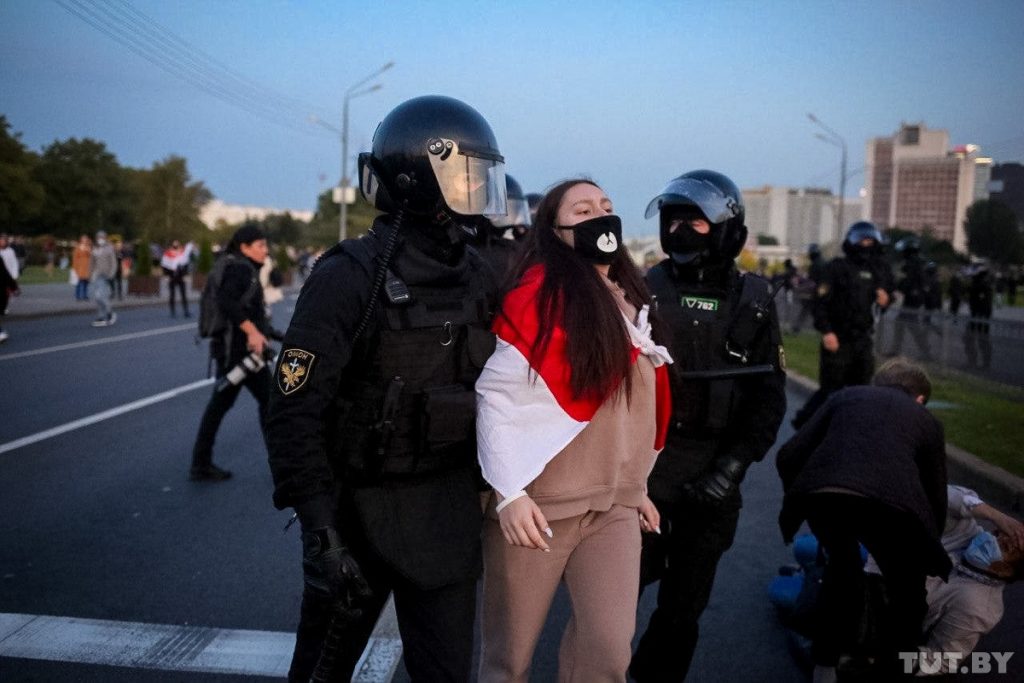Russia planned to take Kyiv in three days — until a secret army blew up Putin’s first move from inside.
“Without our bases, railways, and borders, Putin’s defeat will be significantly hastened.”
That warning, whispered through an encrypted video from deep inside Belarus — Russia’s closest ally — turned out to be prophetic.
As Russian tanks stormed toward Kyiv in February 2022, riding Belarusian railways straight to the front, sudden cyberattacks shattered the system, freezing Russia’s assault when every second counted.
The blow to the Kremlin’s logistics bought Ukraine’s defenders precious weeks to shut down the offensive — and slow the brutal occupation of Kyiv’s suburbs, where atrocities like the Bucha massacre were already unfolding.
Yet the Belarusian Cyber Partisans — the rebel hacker group behind the sabotage — didn’t stop there.
Born under one of the world’s most brutal dictatorships, these digital insurgents exposed the secret police behind Lukashenka’s regime, launched one of the largest cyberattacks on the Kremlin, and turned Belarus from a silent launchpad into a hidden battlefield where Putin’s plans are no longer safe in the place he once trusted most.
The partner in crime
Belarus broke from Moscow’s grip in 1991, only to fall into Aliaksandr Lukashenka’s hands three years later. Over the next decades, the country’s first and only president tightened his grip while binding the country’s energy, military, and economy ever closer to Moscow.
Lukashenka’s seven consecutive terms came at the cost of crushed dissent and a reputation as "Europe’s last dictator," drawing EU sanctions for human rights abuses, rigged elections, and political repression. For years, Lukashenka played both sides — taking Russian subsidies while courting the West just enough to avoid total isolation.
After Russia’s 2014 invasion of Ukraine, he cast Belarus as a neutral buffer — the "Switzerland of Eastern Europe" and kept one foot in each camp, refusing to endorse Crimea’s annexation and blocking Russian troops from using Belarus as a launchpad.
At the same time, Lukashenka cautiously revived Belarusian language and national symbols to fend off deeper Kremlin control — a sharp contrast to his earlier years of suppressing Belarusian identity in favor of Russian dominance.

However, that balancing act collapsed in 2020. After rigging another election — condemned by the West and sparking the largest protests in country’s history — Lukashenka fell fully into Putin’s hands.
The Kremlin helped him crush the uprising, which drew up to 500,000 protesters at its peak, and kept Belarus’s sanctioned economy on life support, with roughly 70% of Belarus’s trade now tied to Moscow.
This dependency turned Belarus into a key launchpad for Putin’s full-scale war in Ukraine — a role Lukashenka once vowed to resist. In 2023, the Kremlin took a step further and deployed its warheads to Belarus, escalating the nuclear threat, while continuing missile strikes on Ukraine from Belarusian soil.
In March 2025, his Misk ally hinted at the next stage of surrender, calling for the Minsk’s “irreversible” integration with Russia.
The hackers that dictators fear
The Belarusian Cyber Partisans emerged in 2020, born from the mass protests against Lukashenka’s stolen election. Formed by anonymous tech experts, the movement initially set out to expose repression, sabotage surveillance, and cripple the security forces keeping the regime alive.
However, what began with leaking police files and hacking state databases quickly evolved into one of the most sophisticated digital resistance movements in Eastern Europe.
In 2023, the Cyber Partisans launched a major cyberattack exposing Belarus’s KGB informants.
“That exposure affected dozens of recruited foreign agents connected to the KGB,” says Yuliana Shemetovets, the group’s spokesperson, about the leak of 40,000 appeals submitted through the Belarusian KGB’s website over the past nine years.
In 2024, the group took a step further and leaked personal files on over 8,600 secret police agents — nearly the entire special force behind Lukashenka’s dictatorship — and launched a photo-identification bot to help citizens expose undercover operatives.
“They still lack the capacity to defend themselves effectively," Shekhovtsova says. They suffer from a shortage of skilled professionals and face difficulties acquiring and operating the necessary technology.”

What another Lukashenko ‘victory’ means for Europe’s security – and that of Belarus’ citizens
Racing against Europe’s last dictatorship
Not surprisingly, the group's activities haven’t gone unnoticed. In December 2021, Belarus’s Supreme Court labeled a network that includes the Cyber Partisans a terrorist organization after the group exposed ties between a pro-government oligarch and Lukashenka’s regime.
The verdict came after its hackers leaked documents showing businessman Aliaksei Aleksin gifted nine luxury cars to Lukashenka’s inner circle in 2018, shortly after gaining control of Belarus’s tobacco industry.
“We are one of the top organizations the regime is actively trying to counter and undermine — and we take that very seriously,” the group's spokesperson said.
Trending Now
However, Belarus is not the only target. In February 2023, the Cyber Partisans hacked Roskomnadzor — Russia’s censorship agency — leaking two terabytes of sensitive data, including 1.5 million emails and over 200,000 sensitive documents in one of the most worst cyberattacks the Kremlin has ever faced.
The hackers retained access to Roskomnadzor’s databases for months, giving the world and international media one of the clearest glimpses into Russia’s repression machine — including directives to block independent media and coordination with the FSB and National Guard to suppress dissent.
These bold operations sent the Cyber Partisans into a new arena — with higher stakes and a new mission ahead.
“Our focus in 2025 remains the same: weakening the systems of the Belarusian and Russian regimes, and assisting investigators worldwide by providing critical data that exposes their crimes,” Yuliana Shemetovets says.

The hackers who bought Ukraine time
However, the Cyber Partisans’ most lasting sabotage wasn’t against Putin’s censorship machine — it was on Belarusian railways, carrying Russian forces to Ukraine’s northern border.
In January 2022, weeks before Russia’s full-scale invasion, the group hacked Belarusian Railways to disrupt Russian troop movements to Ukraine’s border, masked as “joint drills” — forcing the company to fall back to paper-based operations. The attacks continued into the early days of the war, with crippling Russian logistics for two critical weeks during the assault on Kyiv.
Later into the full-scale invasion, the Cyber Partisans also teamed up with the Kastuś Kalinoŭski Regiment, a unit of Belarusian volunteers fighting within Ukraine’s army since March 2022 for the “liberation of Belarus through the liberation of Ukraine.”
Branded a terrorist group by Lukashenka’s regime, the regiment relies on hackers to vet new recruits and feed intelligence to Ukrainian forces.
“Unfortunately, our most significant and successful hacks cannot be disclosed publicly,” the group’s spokesperson says. “For security reasons, we must protect our ongoing access to enemy networks.”
This way, the Cyber Partisans stand shoulder to shoulder with Ukraine’s IT Army in the cyber war against Russia. But while they share a common enemy, their missions are distinct: the Partisans target Lukashenka’s regime from within, while the IT Army unites thousands of international volunteers for an all-out digital assault on the Kremlin.
Yet, both sides have signaled they’re ready to work together if the right opportunity comes.
“We’re pretty keen on linking up with the Partisans down the line,” said Ted, a spokesperson for Ukraine’s IT Army. “If we can bulk up their ops with our DDoS muscle — and it fits our goals — we’re all ears.”

Digital sabotage with real-world impact
According to Pascal Geenens, Director of Threat Intelligence at Radware, the Belarusian Cyber Partisans have become one of the most sophisticated and focused hacktivist groups in Eastern Europe.
“Their cyber operations serve as a reminder that in today's interconnected world, digital frontlines are as critical as physical ones,” he says.
Unlike the sprawling, volunteer-driven IT Army of Ukraine, the Cyber Partisans are a tight, anonymous unit — just 30 members by 2022. A handful handle the hacks; the rest dig through the stolen data. Inside the group, even the members don’t know each other’s identities — except for one: their spokesperson, Yuliana Shemetovets.
According to Vasileios Karagiannopoulos, Associate Professor of Cybercrime and Cybersecurity at the University of Portsmouth, the Cyber Partisans represent a new evolution of hacktivism — merging national resistance with global impact.
“They show a model of organization and tactical development that will be an example for future groups,” he says, adding that strategic media presence and use of a spokesperson help amplify the group’s impact despite the secretive membership.
He highlights that the group’s biggest achievement is forcing Belarus’s political crisis onto the international stage. Their high-profile hacks — from exposing secret service informants to sabotaging state infrastructure — have drawn global attention to their ultimate goal: regime change.
“The collaboration between Belarus and Russia has pushed the Cyber Partisans to consider targets outside the Belarusian cyberspace,” Karagiannopoulos says.
While he stops short of comparing them to decentralized groups like Anonymous, the expert sees the Cyber Partisans as a structured, nation-focused collective with strong ethical roots and growing capabilities that could define the next generation of digital resistance.
The group’s spokesperson, Yuliana Shemetovets, confirmed that the partisans have no plans to stop their resistance.
“Unless Europe stops relying solely on the US for security and develops a real strategy for the region, bringing change to Belarus and Russia will remain difficult,” she says. “Regardless, we will continue our work.”

